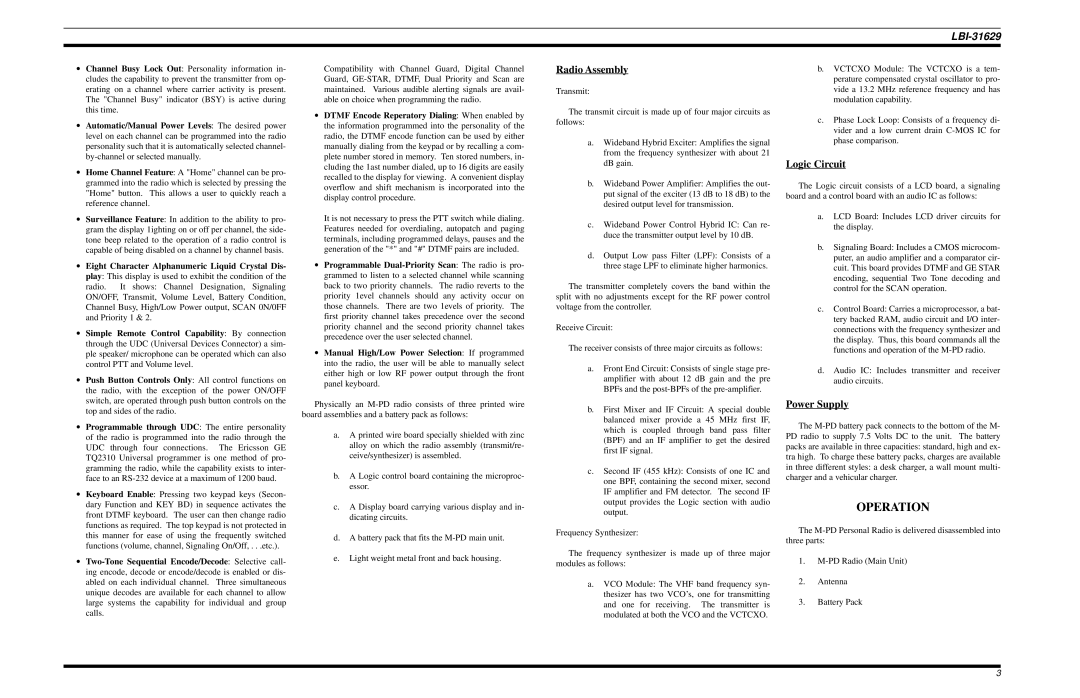
LBI-31629
∙Channel Busy Lock Out: Personality information in- cludes the capability to prevent the transmitter from op- erating on a channel where carrier activity is present. The "Channel Busy" indicator (BSY) is active during this time.
∙Automatic/Manual Power Levels: The desired power level on each channel can be programmed into the radio personality such that it is automatically selected channel-
∙Home Channel Feature: A "Home" channel can be pro- grammed into the radio which is selected by pressing the "Home" button. This allows a user to quickly reach a reference channel.
∙Surveillance Feature: In addition to the ability to pro- gram the display 1ighting on or off per channel, the side- tone beep related to the operation of a radio control is capable of being disabled on a channel by channel basis.
∙Eight Character Alphanumeric Liquid Crystal Dis- play: This display is used to exhibit the condition of the
radio. It shows: Channel Designation, Signaling ON/OFF, Transmit, Volume Level, Battery Condition, Channel Busy, High/Low Power output, SCAN 0N/0FF and Priority 1 & 2.
∙Simple Remote Control Capability: By connection through the UDC (Universal Devices Connector) a sim- ple speaker/ microphone can be operated which can also control PTT and Volume level.
∙Push Button Controls Only: All control functions on the radio, with the exception of the power ON/OFF switch, are operated through push button controls on the top and sides of the radio.
∙Programmable through UDC: The entire personality of the radio is programmed into the radio through the UDC through four connections. The Ericsson GE TQ2310 Universal programmer is one method of pro- gramming the radio, while the capability exists to inter- face to an
∙Keyboard Enable: Pressing two keypad keys (Secon- dary Function and KEY BD) in sequence activates the front DTMF keyboard. The user can then change radio functions as required. The top keypad is not protected in this manner for ease of using the frequently switched functions (volume, channel, Signaling On/Off, . . .etc.).
∙
Compatibility with Channel Guard, Digital Channel Guard,
∙DTMF Encode Reperatory Dialing: When enabled by the information programmed into the personality of the radio, the DTMF encode function can be used by either manually dialing from the keypad or by recalling a com- plete number stored in memory. Ten stored numbers, in- cluding the 1ast number dialed, up to 16 digits are easily recalled to the display for viewing. A convenient display overflow and shift mechanism is incorporated into the display control procedure.
It is not necessary to press the PTT switch while dialing. Features needed for overdialing, autopatch and paging terminals, including programmed delays, pauses and the generation of the "*" and "#" DTMF pairs are included.
∙Programmable
∙Manual High/Low Power Selection: If programmed into the radio, the user will be able to manually select either high or low RF power output through the front panel keyboard.
Physically an
a.A printed wire board specially shielded with zinc alloy on which the radio assembly (transmit/re- ceive/synthesizer) is assembled.
b.A Logic control board containing the microproc- essor.
c.A Display board carrying various display and in- dicating circuits.
d.A battery pack that fits the
e.Light weight metal front and back housing.
Radio Assembly
Transmit:
The transmit circuit is made up of four major circuits as follows:
a.Wideband Hybrid Exciter: Amplifies the signal from the frequency synthesizer with about 21 dB gain.
b.Wideband Power Amplifier: Amplifies the out- put signal of the exciter (13 dB to 18 dB) to the desired output level for transmission.
c.Wideband Power Control Hybrid IC: Can re- duce the transmitter output level by 10 dB.
d.Output Low pass Filter (LPF): Consists of a three stage LPF to eliminate higher harmonics.
The transmitter completely covers the band within the split with no adjustments except for the RF power control voltage from the controller.
Receive Circuit:
The receiver consists of three major circuits as follows:
a.Front End Circuit: Consists of single stage pre- amplifier with about 12 dB gain and the pre BPFs and the
b.First Mixer and IF Circuit: A special double balanced mixer provide a 45 MHz first IF, which is coupled through band pass filter (BPF) and an IF amplifier to get the desired first IF signal.
c.Second IF (455 kHz): Consists of one IC and one BPF, containing the second mixer, second IF amplifier and FM detector. The second IF output provides the Logic section with audio output.
Frequency Synthesizer:
The frequency synthesizer is made up of three major modules as follows:
a.VCO Module: The VHF band frequency syn- thesizer has two VCO’s, one for transmitting and one for receiving. The transmitter is modulated at both the VCO and the VCTCXO.
b.VCTCXO Module: The VCTCXO is a tem- perature compensated crystal oscillator to pro- vide a 13.2 MHz reference frequency and has modulation capability.
c.Phase Lock Loop: Consists of a frequency di- vider and a low current drain
Logic Circuit
The Logic circuit consists of a LCD board, a signaling board and a control board with an audio IC as follows:
a.LCD Board: Includes LCD driver circuits for the display.
b.Signaling Board: Includes a CMOS microcom- puter, an audio amplifier and a comparator cir- cuit. This board provides DTMF and GE STAR encoding, sequential Two Tone decoding and control for the SCAN operation.
c.Control Board: Carries a microprocessor, a bat- tery backed RAM, audio circuit and I/O inter- connections with the frequency synthesizer and the display. Thus, this board commands all the functions and operation of the
d.Audio IC: Includes transmitter and receiver audio circuits.
Power Supply
The
OPERATION
The
1.
2.Antenna
3.Battery Pack
3
